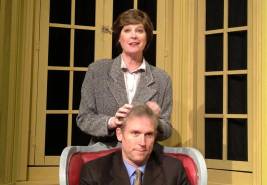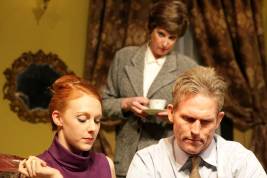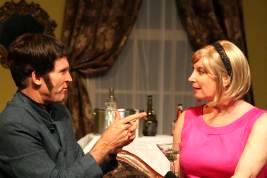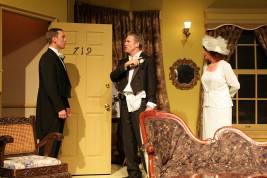
Neil Simon was the reigning King Of Broadway when his Plaza Suite opened at the Plymouth Theatre on Valentine’s Day, 1968. Only two years before, Simon’s Sweet Charity, The Star-Spangled Girl, The Odd Couple, and Barefoot in the Park were all four playing simultaneously on the Great White Way, and Plaza Suite, the next Simon comedy to open in New York ran over a thousand performances and on into the next decade.
It’s this still rib-tickling, still relevant collection of three short plays, each of them unfolding in Suite 719 of New York’s posh and pricey Plaza Hotel, that the Morgan-Wixson Theatre now revives to near perfection in a production blessed by inspired direction and a pair of sensational lead performances.
 The seventh of Neil Simon’s thirty-four full-length plays, Plaza Suite was the first to give audiences an evening of one-acts, something he later repeated in California Suite and London Suite. In Plaza Suite there are three of them, each with a quite different tone but held together by a) a single locale and b) a single pair of actors playing all six parts.
The seventh of Neil Simon’s thirty-four full-length plays, Plaza Suite was the first to give audiences an evening of one-acts, something he later repeated in California Suite and London Suite. In Plaza Suite there are three of them, each with a quite different tone but held together by a) a single locale and b) a single pair of actors playing all six parts.
George C. Scott and Maureen Stapleton originated the roles now played at the Morgan-Wixson by Howard Lockie and Andrea Stradling—in Act One, a couple whose twenty-plus year marriage has gone sour; in Act Two, former high school sweethearts meeting for the first time since the onetime teen boyfriend’s current success as a big-time Hollywood producer; and in Act Three, as a pair of harried marrieds whose 20ish daughter has locked herself in the bathroom on her wedding day and won’t come out.
Though each audience member will likely have his or her own favorite act, Plaza Suite is well worth seeing if only for Act One, a bittersweet dramedy that presages Simon’s darker undertones in The Gingerbread Lady, The Prisoner Of Second Avenue, and his Pulitzer Prize-winning Lost In Yonkers.
 “Visitor From Mamaroneck” introduces us to Sam and Karen Nash, the latter of whom has planned an overnight celebration of their twenty-fourth anniversary in the selfsame suite in which they spent their honeymoon night, only to be told by her workaholic spouse in the most dismissive tone imaginable that she’s got it wrong about both the number of years they’ve been married and the room number of their honeymoon suite.
“Visitor From Mamaroneck” introduces us to Sam and Karen Nash, the latter of whom has planned an overnight celebration of their twenty-fourth anniversary in the selfsame suite in which they spent their honeymoon night, only to be told by her workaholic spouse in the most dismissive tone imaginable that she’s got it wrong about both the number of years they’ve been married and the room number of their honeymoon suite.
What sets Act One apart from Acts Two and Three is that, if it weren’t for its forty-minute string of can’t-miss jokes, some of which come from Karen’s inability to remember even her own age, others from her defense-mechanism quips about Sam’s mid-life obsession with his weight (and the many evenings spent “working late” with his very pretty, very young secretary Jean)—minus these many laughs, what Simon gives us (and what Lockie and a particularly superb Stradling reveal) is a stark, even bleak look at a marriage about to self-destruct.
 After Act One’s seriocomic brilliance, Act Two’s refreshingly light and playful “Visitor From Hollywood” comes as a welcome comedic bonbon, with suburban housewife Muriel Tate meeting up with mega-movie producer Jesse Kiplinger seventeen years after his departure from their hometown on his way to Tinseltown fame. The slick, self-obsessed Hollywood mogul’s attempts to seduce his star-struck onetime flame (who keeps switching the time she’s expected back home even as she downs one vodka stinger after another) make for a considerably brighter, breezier second act, and one which showcases Lockie’s and Stradling’s versatility and spot-on comic timing.
After Act One’s seriocomic brilliance, Act Two’s refreshingly light and playful “Visitor From Hollywood” comes as a welcome comedic bonbon, with suburban housewife Muriel Tate meeting up with mega-movie producer Jesse Kiplinger seventeen years after his departure from their hometown on his way to Tinseltown fame. The slick, self-obsessed Hollywood mogul’s attempts to seduce his star-struck onetime flame (who keeps switching the time she’s expected back home even as she downs one vodka stinger after another) make for a considerably brighter, breezier second act, and one which showcases Lockie’s and Stradling’s versatility and spot-on comic timing.
Making Act Two a particularly nostalgic delight for audience members of a certain age are its string of references to ‘60s celebs, from Elke Sommer to Charlton Heston to Joesph E. Levine to Virna Lisi to Stella Stevens to Frank Sinatra circa Mia Farrow—leading to quite possibly the most hilarious seduction ever, one in which the dropping of names proves the ultimate aphrodisiac.
 Last but not least, there’s Act Three’s “Visitor From Forest Hills,” Plaza Suite’s slapstickiest Act, and the one which allows its two stars (and Hockey in particular) to display physical comedy that would do Steve Martin, Lucille Ball, or Jerry Lewis proud, with Hockey’s Roy hurling himself ineffectually (and painfully) against the locked bathroom door and climbing out onto the seventh-story ledge in hopes of an open bathroom window and a daughter willing to listen to Dad’s orders to “Get married or else!”, his previous efforts to cajole having been for naught.
Last but not least, there’s Act Three’s “Visitor From Forest Hills,” Plaza Suite’s slapstickiest Act, and the one which allows its two stars (and Hockey in particular) to display physical comedy that would do Steve Martin, Lucille Ball, or Jerry Lewis proud, with Hockey’s Roy hurling himself ineffectually (and painfully) against the locked bathroom door and climbing out onto the seventh-story ledge in hopes of an open bathroom window and a daughter willing to listen to Dad’s orders to “Get married or else!”, his previous efforts to cajole having been for naught.
Best Actor/Best Director Scenie winner Michael Rothhaar deserves highest marks for his sharp, savvy direction, and for encouraging Lockie and Stradling to dig deep, the better to create six very real, very human characters without ever losing sight of the fact that when playing Neil Simon, performers must maintain a constant awareness of which words need to be punched and which pauses to be held, the better to score maximum audience laughter.
Lockie’s hard-as-nails, cold-as-ice performance as Act One’s Sam proves the perfect counterpart to Stradling’s magnificent, heartbreaking Karen, revelatory work from an actress who has been one of our brightest community theater stars on the other side of downtown for the past couple of decades and now gives West Side audiences her richest, most rewarding work to date.
Following Act One’s mix of marital despair sprinkled with laugh upon laugh, Act Two’s saucy, sexy seduction comes as not only welcome pure-comic relief but a chance to see Lockie tickle our funny bone as a cocky, Nehru-jackected lothario and Stradling equally delightful as the giddy blonde object of his attempted seduction.
Finally, there’s Act Three’s madcap mix of parental threats and pleas and recriminations—and some broad physical comedy by Lockie’s Roy and Stradling’s Norma that would do Harvey Korman and Carol Burnett proud.
Stradling’s three wigs and Lockie’s brunet, sideburned hairpiece in Act Two help considerably in giving us six very different characters, as do Kristy Pace’s spot-on 1960s costumes (with special snaps for Roy’s break-apart tuxedo)—though ultimately it’s the actors themselves who do the lion’s share of the work—and splendidly so.
Alicia Craff (as secretary Jean and unwilling bride Mimsy) and Karol Garrison (as a bellhop, a Russian waiter, and bridegroom Borden) shine brightly in their brief, well-played appearances.
Producer William Wilday has designed a living-room/bedroom suite that makes a fine first impression, though a closer look at paint and upholstery and a skyscraper-free skyline reveals that this isn’t quite the Plaza Suite a bigger-budget production would provide. No matter, his lighting is first-rate (with a terrific Act One fade to black) as is his sound design. A medley of late-‘60s hits (including Burt Bacharach’s “Do You Know The Way To San Jose” and Paul Mauriat’s “Love Is Blue”) aids greatly in sending us back in time (though you won’t hear any of the decade’s more politically inspired songs, and rightfully so).
Brian Raine is associate producer and Laura Levin stage manager.
There may be no cell phones or laptops or texting or tweeting in Neil Simon’s Plaza Suite, but there are probably just as many Sams and Karens and Jesses and Muriels and Roys and Normas alive and well and living only a stone’s throw from New York’s Plaza Hotel in 2013, making Plaza Suite both a nostalgic time capsule and a still pertinent comedic treat. And since an overnight stay in a suite at today’s Plaza would likely cost you anywhere from forty to fifty times the price of a single ticket to Plaza Suite at the Morgan-Wixson, there’s no better comedy bargain in town.
Morgan-Wixson Theatre, 2627 Pico Boulevard, Santa Monica.
www.Morgan-Wixson.org
–Steven Stanley
January 26, 2013
Photos: Joel Castro


 Since 2007, Steven Stanley's StageSceneLA.com has spotlighted the best in Southern California theater via reviews, interviews, and its annual StageSceneLA Scenies.
Since 2007, Steven Stanley's StageSceneLA.com has spotlighted the best in Southern California theater via reviews, interviews, and its annual StageSceneLA Scenies.







 COPYRIGHT 2024 STEVEN STANLEY :: DESIGN BY
COPYRIGHT 2024 STEVEN STANLEY :: DESIGN BY